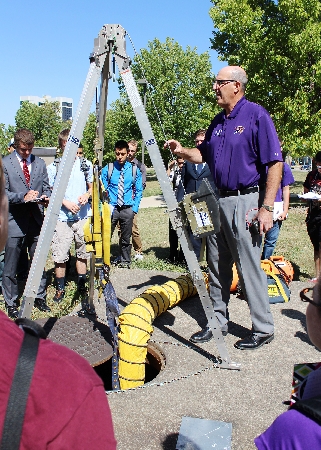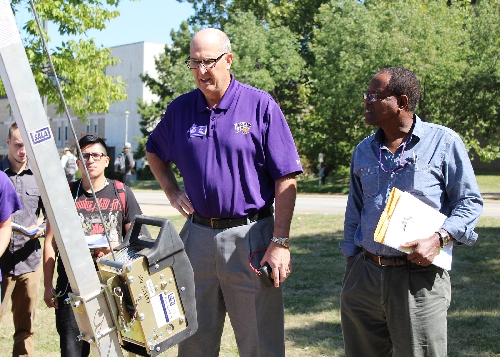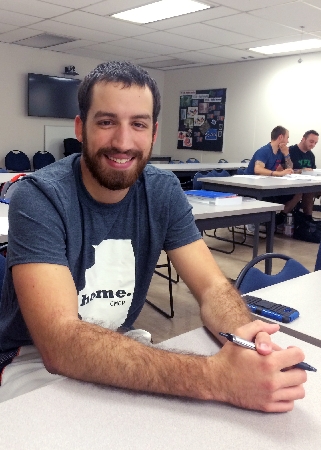University News
WIU Students Get First-Hand Look at Hazards, Regulations for Working in Permit-Required Confined Spaces
October 5, 2015
MACOMB, IL — There are more than 50 confined spaces on Western Illinois University's Macomb campus. On any given work day at Western, technicians in WIU Facilities Management may find themselves working in one of these potentially dangerous work sites.
Recently, Fetene Gebrewold, professor in the WIU Department of Health Sciences and Social Work, brought in one of those employees, Don Mutch, an environmental health and safety technician II, to show Gebrewold's students the practical and necessary safety aspects of working in a confined space. A "permit-required" confined space can include underground utility holes, tanks, silos or pipelines and have such characteristics as limited openings for workers to enter and exit, the potential to contain hazardous atmospheres, as well as internal configurations in which entrants could be trapped.
Mutch's Sept. 15 presentation to students in Gebrewold's Environmental and Occupational Safety (EOS) 377 course used one of the many permit-required confined spaces (covered in 29 CFR [Code of Federal Regulations] 1910.146, U.S. Dept. of Labor, Occupational and Health Safety Administration [OSHA]) on campus to demonstrate how to use such equipment as harnesses and air-quality monitoring devices, as well as the need for using three workers (an entrant, attendant and entry supervisor) when working on a permit-required confined space job site.
The EOS 377 course, which enables students to earn OSHA 30-hour general industry certification credentials, according to Gebrewold, covers the fundamentals of permit-required confined spaces, as well as hazardous-waste regulations, industrial hygiene requirements, workplace violence and accident causation theories.
"Don's presentation provided us with a mini field trip and showed the students how to apply OHSA regulations," Gebrewold said. "Before we went to the confined space site, which was between Horrabin and Stipes halls, Don gave students an overview of what permit-required confined spaces are and the safety hazards involved with working in them."
Gebrewold said Mutch informed students there are more than 1.6 million Americans who work in confined spaces each year, and serious injury or death can result from working in a confined space.
"Some of the hazards Don talked to us about include engulfment, electric shock, falls and heat stress. OSHA officials believe 85 percent of these accidents can be prevented, and Don's presentation and demonstration emphasized the importance of employers taking action to control the hazards of working in permit-required confined spaces," Gebrewold added.
Dustin Rhodes (Beardstown, IL), a senior public heath major, said it was beneficial to see the procedures in action.
"It was helpful to have the visual demonstration, instead of just reading about it in a book. We got to see the harnesses they use and all the equipment used during working in a confined space. I thought it was pretty interesting," Rhodes noted.
"Before the demonstration, Don talked to us about what confined space is and which ones require a permit and which ones don't. We also talked about the mechanisms used, and we saw a video presentation," added Gabriel Leon (Bolingbrook, IL), a senior law enforcement major who is minoring in occupational safety. "This class gives us an understanding of occupational safety, and I feel like it prepares us for working in the field, because it's a hands-on class."
For Brendan Kane (Geneva, IL), a senior human resources management major, the course was an elective in his major program, but he feels the knowledge he has gained, as well as the OSHA certification, will be immensely beneficial in his aspirations to work for the federal government.
"I was going to take the class anyway, so it was a bonus to get the OSHA certification. The additional fee, $5, is totally worth it, and it's nice that it's part of coursework," Kane said. "For the unit on permit-required confined spaces, we learned the goal is to keep the employees safe from different hazards, such as monitoring the oxygen levels in a confined space and the importance of using the proper equipment and following the regulations. I found it all interesting about how it all works."
For more information, contact Gebrewold at (309) 298-1736 or via email at F-Gebrewold@wiu.edu.
Posted By: Teresa Koltzenburg (WIUNews@wiu.edu)
Office of University Communications & Marketing






Connect with us: